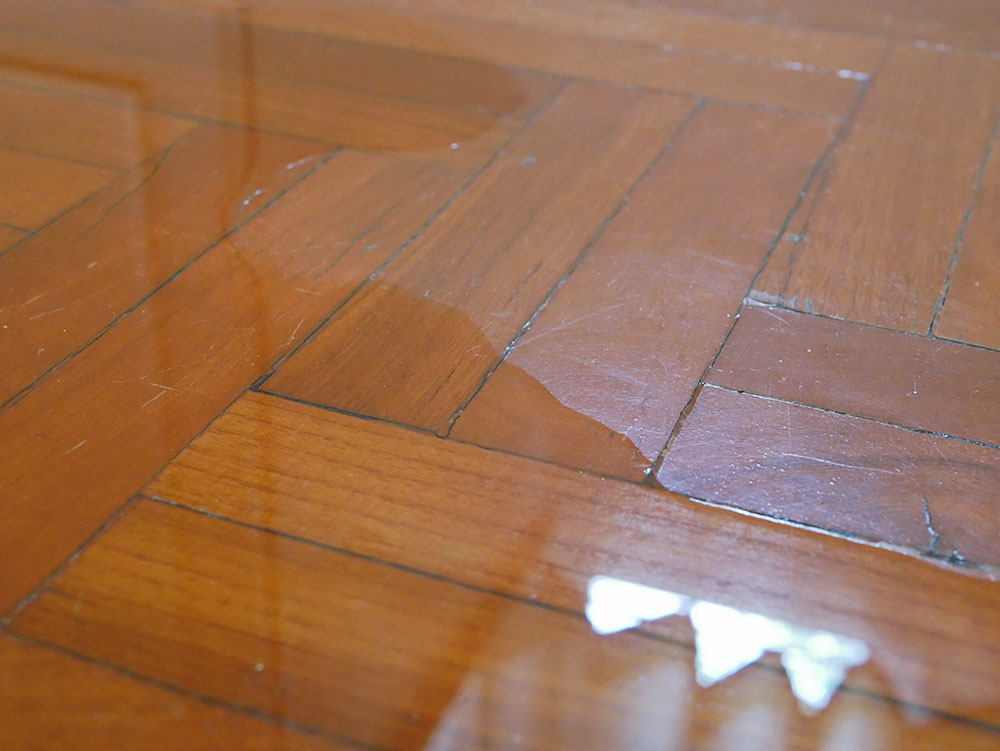How To Restore Water-Damaged Wood Floor

CONTENTS
- How water affects wood
- The risks of a water-damaged floor
- How to spot water damage early on
- What to do if there is water damage in your home
- Get in touch
A flood can severely damage your belongings as well as the structure of your home. Wooden objects and floors are more susceptible to permanent damage due to their porous nature and may rot over time without professional intervention.
Here at ICE Cleaning, we offer effective and rapid flood restoration services. Our IOSH-accredited technicians can drain all the water from your property, dry out the affected areas, and clean the air to make your property safe to occupy again.
Read on to learn more about how water affects a wooden floor and how to restore it.
How water affects wood
Whether you have just suffered a flood or a burst pipe has spilt water across a wooden surface, you must act quickly to either absorb some of the water or contact a flood clean-up service.
Because wood is a porous material, it absorbs moisture easily, and this could quickly lead to swelling, rotting, or mould growth. However, certain types of wood resist large amounts of water damage.
Depending on the type of wood your floor is, you may find there is less visual damage. The brand of finish you use on your flooring should also make a big difference and could make it more water-resistant.
Hardwood flooring is particularly vulnerable to water damage, swelling, and shrinkage. It is important to note that while there are no waterproof floors, there are wood types that are more resistant to water damage. The following wood types are the most water-resistant floors:
- Teak
- White oak
- Brazilian walnut
- Maple hardwood
The risks of a water-damaged floor
Various risks are involved with a water-damaged floor, depending on the source of the water. If the damage was due to a flood or sewage spill, the wooden floor would absorb the water and harbour incredibly harmful bacteria.
Your floor’s surface will be covered in waterborne pathogens like E. coli and Salmonella, presenting a health risk and a structural hazard. Regardless of the water damage, your floorboards could become a breeding ground for mould, mildew, and other fungi.
These can discolour the floor and cause the wood to rot, exposing people to airborne mould spores. This is a significant risk to elderly, young, and immunocompromised individuals. You might begin to experience symptoms of mould exposure like:
- Coughing
- Headache
- Irritated skin and eyes
- Sneezing
- Nasal congestion
- Chest tightness
- Shortness of breath
How to spot water damage early on
If you have managed to contain the water damage or used absorbent materials to soak up the remaining water, you may notice your floorboards changing colour or warping. The signs will be subtle at first, but the following indicators may appear after the water has subsided:
- The wood boards will start to swell into each other, causing the middle to dip downwards
- Black or dark brown stains can appear around the edges of the boards
- Nails in the wood might show signs of rusting or corrosion
- The boards may rise and buckle, causing splintering and potentially breakage
- A musty smell appears indicating mould or mildew growth
When you notice these signs, your floor is unsafe to continue stepping on and might break with increased pressure. Mould and mildew may have started to grow, too, posing a health threat to you. This requires immediate repair or restoration with the help of a flood damage cleaning company.
What to do if there is water damage in your home
If your wood floor is at risk of water damage due to a burst pipe, you can do a few things to contain the water and prevent it from spreading to other areas of your home. You should:
- Turn off the water supply if you have access to it
- Place a large pan or bucket under the leak or spill
- Call a water damage cleaning company
- Contact your insurance to inform them of any damages
- Contain and drain the water with absorbents
- Drain the pipes in your home by turning on taps, showers, baths, and flushing your toilet until there is no water
- Open all windows and doors to circulate the air around your property
- Place a dehumidifier in the affected area
Tackling clean water is always much safer as there is little risk of encountering harmful bacteria. However, you must leave the restoration process to the professionals.
In the event of black water or sewage spilling onto your floor, you must not try to clean or contain it yourself. You could expose yourself to biohazardous waste and potentially harmful bacteria.
Instead, take pictures of the damage from a safe distance, leave the property to contact your insurance, and call a flood damage cleaning company.
Get in touch
Our technicians can restore your water-damaged floor with our flood damage cleaning services. Our expert cleaners will utilise state-of-the-art technology and solutions to effectively dry your property and make it safe to occupy once again.
If you want to know more about our specialist cleaning services, contact our friendly service team at 0208 066 0360 or enquiries@icecleaning.co.uk. We are available 24 hours a day, seven days a week, and can be on-site within a matter of hours in an emergency.

Speak with me today,
I’m here to help
By asking you a few questions either via phone or email I can immediately provide a realistic estimation of the cost.
You’re in good company. We’ve cleaned for the following commercial clients… View all

Why choose us?
- Cater to a wide variety of cleaning situations
- Nationwide coverage, available 24/7
- Cater to commercial and domestic clients
- Free survey provided prior to quotation
- Emergency response team
- Offer a bespoke service designed to suit all your needs
- All technicians hold professional health and safety qualifications, including BICSc, IOSH, Dewpoint Professional & Safe Contractor
We’re fully accredited
We place best practise, professional expertise and health and safety at the core of our business. We’re fully compliant with all legal obligations. You can view a list of our accreditations below, or visit our Health & Safety page for more information.











-RGB-small.1707319151.jpg)




















